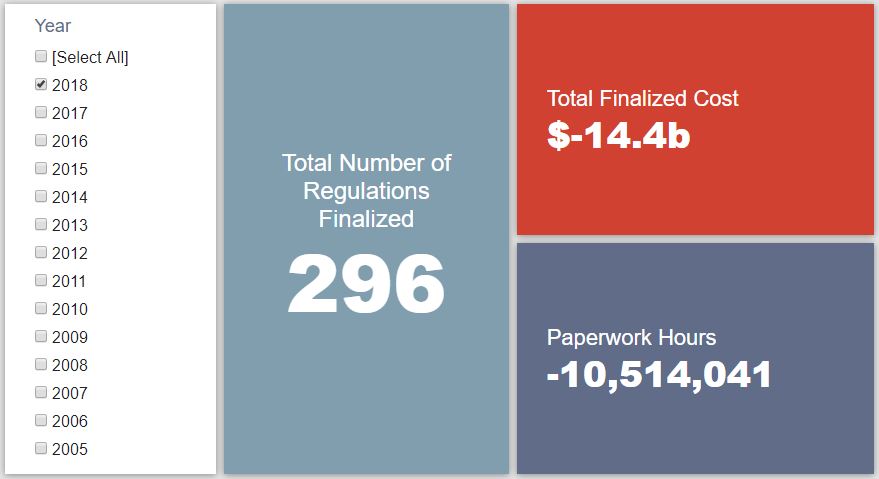Week in Regulation
December 10, 2018
Deregulatory Proposals Carry The Week
Entering the final month of 2018, a pair of deregulatory proposed rules led a fairly modest week in the Federal Register. The proposals – from the Departments of Homeland Security (DHS) and Defense (DOD) – could combine for nearly $1 billion in total cost savings. Between both proposed and final rules last week, agencies published $926.9 million in net cost savings, and reduced paperwork by 504,365 hours. The per capita regulatory burden for 2018 is negative $43.86.
REGULATORY TOPLINES
- New Proposed Rules: 29
- New Final Rules: 73
- 2018 Total Pages of Regulation: 63,090
- 2018 Final Rules: -$14.4 Billion
- 2018 Proposed Rules: -$546.3 Billion
TRACKING REGULATORY MODERNIZATION
The most significant cost-cutting measure of the week comes from DHS. The proposed rule seeks to adjust the “Registration Requirement for Petitioners Seeking To File H-1B Petitions on Behalf of Cap-Subject Aliens.” DHS estimates that, under a scenario where affected petitioners hire outside counsel, this change could reduce costs to affected entities by roughly $65 million annually (or $652 million over 10 years). DHS also estimates that it could save $14 million in government spending.
The other notable deregulatory proposal from last week comes from DOD. That proposed rule focuses on the “Revision of Limitations on Subcontracting.” Specifically, it would adjust certain government contracting regulations to align better with previous adjustments made by the Small Business Administration. DOD estimates that this revision could produce roughly $271 million in total cost savings. Neither of these measures, however, currently applies to the fiscal year (FY 2019) regulatory budget under Executive Order (EO) 13,771 since they are both still in the proposed rule stage.
There were two relatively minor EO 13,771 actions last week though. Both come from the Department of Transportation (DOT). The first would extend the compliance date of a 2015 rule on “Lease and Interchange of Vehicles; Motor Carriers of Passengers” by two years, eventually producing $14.6 million in savings over the next decade. The second DOT rule would stay a rule on the “System Safety Program” for railways by nine months, bringing approximately $250,000 in savings.
So far in FY 2019, there have been 17 deregulatory actions against two regulatory actions (per the rubric created by EO 13,771 and the administration’s subsequent guidance document) with quantified net savings of roughly $5.1 billion. The administration’s cumulative savings goal for FY 2019 is approximately $18 billion.
STATE OF MAJOR OBAMA-ERA INITIATIVES
Based on total lifetime costs of the regulations, the Affordable Care Act has imposed costs of $52.9 billion in final state and private-sector burdens and 176.9 million annual paperwork hours.
Since passage, the Dodd-Frank financial reform legislation has produced more than 82.9 million final paperwork burden hours and imposed $38.9 billion in direct compliance costs.
TOTAL BURDENS
Since January 1, the federal government has published $560.7 billion in net cost savings (with $14.4 billion in net savings from final rules) and paperwork burdens amounting to roughly 6 million hours (including 10.5 million hours of paperwork reduced under final rules). Click here for the latest Reg Rodeo findings.











